Zoom
Trash
Related: Sketchnote, lapbook
- Communication
- Social Change
- pedagogie
- INGENIERIE PEDAGOGIQUE
- ECONOMIE
- neurosciences
- Entreprendre autrement
- Education
- Enterprise

En B2B aussi, la data est un levier indispensable de la performance ! Nombre d’analyses matérialisent la même situation : en moyenne, à peine la moitié des données structurées des entreprises contribuent à leurs prises de décisions.
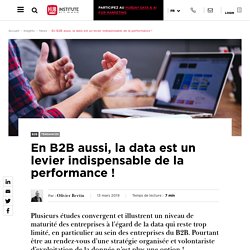
Mais c’est l’arbre qui cache la forêt. Moins de 5% seulement des données non structurées sont quant à elles prises en compte. Les infrastructures et les solutions utilisées par les entreprises ne sont, la plupart du temps, pas encore à la hauteur des enjeux. Gartner Reprint. Research Highlights What Is a 360-Degree View and How Can It Be Used to Improve CX?
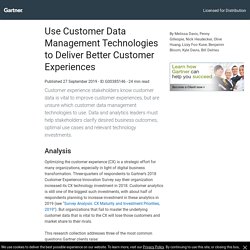
The CX is a key, often strategic, differentiator for many organizations. Delivering a meaningful and effortless CX can create and sustain customer satisfaction, loyalty and advocacy. It also increases customer lifetime value and improves profitability because it can cut customer acquisition costs and boost revenue. A 360-degree view is the output of a consolidated, integrated, exhaustive set of data relevant to a company’s relationship with its customers or prospects.
For most companies, achieving a complete 360-degree view of their customers is out of reach and not recommended, given the acquisition and integration costs for the necessary data. Strategies such as sharing customer data (unique customer identifiers, for example) or providing continuity between channels hinge on the ability to recognize individual customers and their interactions across channels. Related Research: Related research: Figure 2. Which Countries Are Leading the Data Economy? Executive Summary Which countries are the top data producers?
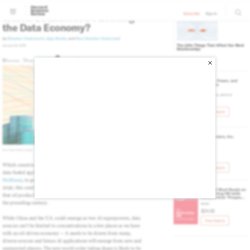
With data-fueled applications of artificial intelligence projected, by McKinsey, to generate $13 trillion in new global economic activity by 2030, this could determine the next world order, much like the role that oil production has played in creating economic power players in the preceding century. While China and the U.S. could emerge as two AI superpowers, data sources can’t be limited to concentrations in a few places, as we have with an oil-driven economy — it needs to be drawn from many, diverse sources and future AI applications will emerge from new and unexpected players. The new world order taking shape is likely to be more complex than a simple bi-polar structure. Building on our past work mapping the digital evolution and digital competitiveness of different countries around the world, we tried mapping the deepest and widest pools of useful data. Which countries are the top data producers? 1. Data-management et data-governance : quelle est la différence ? On est donc passé en quelque sorte d’une vision “outillage” (l’infrastructure, les stockage, …) à une vision “qualité” (la nature même de la donnée, sa forme, sa cohérence, sa réutilisation possible pour tous les services de l’entreprise), et peu à peu on passe à la vision “valeur” (comment construit-on de la valeur de cette donnée, en l’associant à quelle autre donnée, avec quelles normes, quelle éthique, en conformité avec quelle réglementation, au service de quelle stratégie).

Data Management pour valoriser les données comme capital stratégique. Isaac Asimov Asks, “How Do People Get New Ideas?” Note from Arthur Obermayer, friend of the author: In 1959, I worked as a scientist at Allied Research Associates in Boston.

The company was an MIT spinoff that originally focused on the effects of nuclear weapons on aircraft structures. The company received a contract with the acronym GLIPAR (Guide Line Identification Program for Antimissile Research) from the Advanced Research Projects Agency to elicit the most creative approaches possible for a ballistic missile defense system. The government recognized that no matter how much was spent on improving and expanding current technology, it would remain inadequate.
They wanted us and a few other contractors to think “out of the box.” When I first became involved in the project, I suggested that Isaac Asimov, who was a good friend of mine, would be an appropriate person to participate. How do people get new ideas? One way of investigating the problem is to consider the great ideas of the past and see just how they were generated. Gartner Reprint. What Is Driving the Top 10 Data and Analytics Technology Trends?
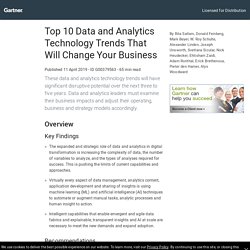
The expanded and strategic role of data and analytics in digital transformation is increasing the complexity of data, the number of variables to be analyzed, the types of analysis, and the speed of analysis required for success. With this increasing complexity comes ever more subtle and potentially damaging risks and challenges, such as the potential for bias and the need for transparency and trust in analytics and in ML and AI models. The size, complexity and distributed nature of data needed for increasingly closer to real-time and optimized decision making means that rigid architectures and tools are breaking down. This complexity is pushing the limits of current approaches, and is leading to unprecedented cycles of rapid innovation in data and analytics to meet the new requirements. The strategic technologies covered in this research (and summarized in Figure 1) represent trends that you cannot afford to ignore.
Blog.datarobot. Back when I was doing my undergraduate degree, I remember being asked to proofread a friend’s economics essay.
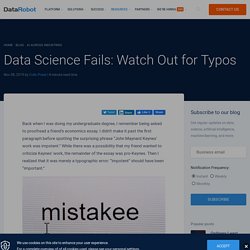
I didn’t make it past the first paragraph before spotting the surprising phrase “John Maynard Keynes' work was impotent.” While there was a possibility that my friend wanted to criticize Keynes’ work, the remainder of the essay was pro-Keynes.